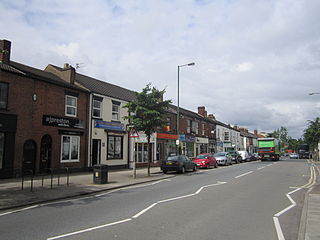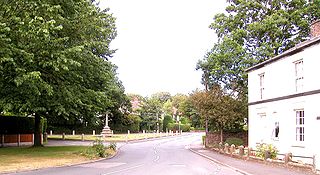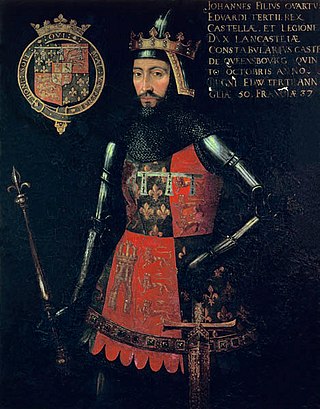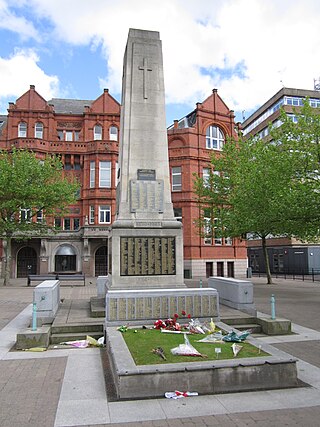
Lancashire is a ceremonial county in North West England. It is bordered by Cumbria to the north, North Yorkshire and West Yorkshire to the east, Greater Manchester and Merseyside to the south, and the Irish Sea to the west. The largest settlement is Blackpool, and the county town is the city of Preston.

Newton-le-Willows is a market town in the Metropolitan Borough of St Helens, Merseyside, England. The population at the 2011 census was 22,114. Newton-le-Willows is on the eastern edge of St Helens, south of Wigan and north of Warrington.

Ashton-in-Makerfield is a market town in the Metropolitan Borough of Wigan, Greater Manchester, England, 4 miles (6.4 km) south of Wigan. As of the 2021 census, there was a population of 26,380.

The Salford Hundred was one of the subdivisions of the historic county of Lancashire in Northern England (see:Hundred. Its name alludes to its judicial centre being the township of Salford. It was also known as the Royal Manor of Salford and the Salford wapentake.

St Helens is a town in Merseyside, England, with a population of 102,629. It is the administrative centre of the Metropolitan Borough of St Helens, which had a population of 183,200 at the 2021 Census.

Lancashire is a county of England, in the northwest of the country. The county did not exist in 1086, for the Domesday Book, and was apparently first created in 1182, making it one of the youngest of the traditional counties.

Hindley is a town within the Metropolitan Borough of Wigan in Greater Manchester, England. It is three miles (4.8 km) east of Wigan and covers an area of 2,580 acres (1,044 ha). Within the boundaries of the historic county of Lancashire, Hindley borders the towns and villages of Ince-in-Makerfield, Aspull, Westhoughton, Atherton and Westleigh in the former borough of Leigh. In 2001, Hindley had a population of 23,457, increasing to 28,000 at the 2011 Census. It forms part of the wider Greater Manchester Urban Area.

The Liverpool–Wigan line is a railway line in the north-west of England, running between Liverpool Lime Street and Wigan North Western via St Helens Central station. The line is a part of the electrified Merseyrail Liverpool to Wigan City Line. The stations, and all trains serving it, are operated by Northern Trains, however the stations are branded Merseyrail using Merseyrail ticketing.

Aughton is a village and civil parish in the West Lancashire district of Lancashire, England. It is located between Ormskirk and Maghull, approximately 10 miles (16 km) north of Liverpool and 17 miles (27 km) south-west of Preston.

The Manchester–Southport line is a railway line in the north-west of England, operated by Northern Trains. It was originally built as the Manchester and Southport Railway. The section between Wigan and Salford is also known locally as the Atherton Line.
The Cheshire County League was a football league founded in the north west of England in 1919, drawing its teams largely from Cheshire, surrounding English counties and North Wales.

Windle is a suburb of St Helens, civil parish and ward of the metropolitan borough of the same name. The population of Windle was given as 10,690 at the 2011 Census. It was one of the original four townships alongside Eccleston, Parr and Sutton formed that merged to become St Helens. The name derives from Windy Hill.

The High Sheriff of Lancashire is an ancient officer, now largely ceremonial, granted to Lancashire, a county in North West England. High Shrievalties are the oldest secular titles under the Crown, in England and Wales. The High Sheriff of Lancashire is the representative of the monarch in the county, and is the "Keeper of The King's Peace" in the county, executing judgements of the High Court through an Under Sheriff.

St Helens is a large town and the administrative seat of the Metropolitan Borough of St Helens in Merseyside, England. The town was incorporated as a municipal borough in 1868, responsible for the administration of the four townships and manors of Eccleston, Parr, Sutton and Windle. In 1887 this role was expanded to a county borough, which was superseded in 1974 by the larger metropolitan borough.
The archdeacons in the Diocese of Liverpool are senior ecclesiastical officers in the Church of England in a highly irregular area surrounding the city of Liverpool. They are the archdeacons of Liverpool, of St Helens and Warrington, of Knowsley and Sefton, and of Wigan and West Lancashire; each one has responsibility over a geographical area within the diocese. The archdeacons are responsible for the disciplinary supervision of the clergy within their archdeaconries.

South Lancashire is a geographical county area, used to indicate the southern part of the historic county of Lancashire, today without any administrative purpose. The county region has no exact boundaries but generally includes areas that form the West Derby Hundred and the Salford Hundred, both of which formed the South Lancashire parliament constituency from 1832. This constituency was further divided in 1868 forming the South East Lancashire and South West Lancashire constituencies. Today the area is still recognized by the government and organisations, including the National Health Service. South Lancashire includes the cities of Manchester and Liverpool.
















